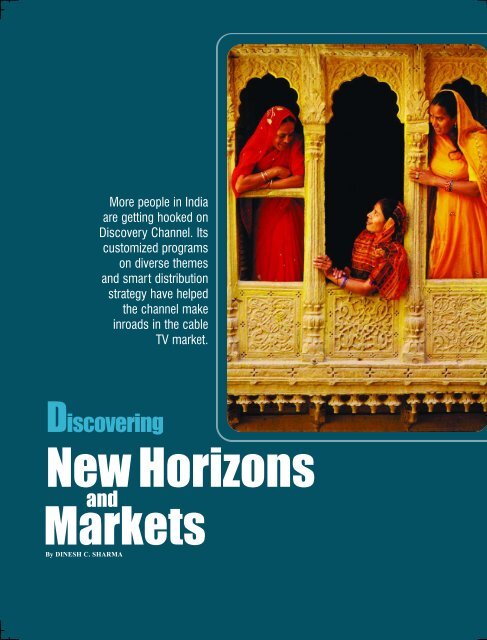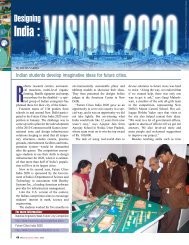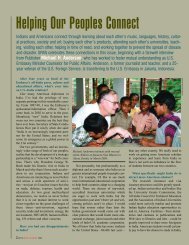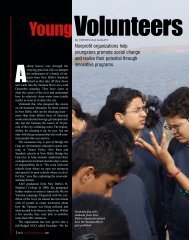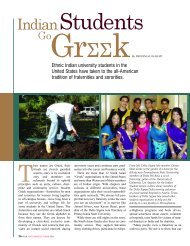Discovering New Horizons and Markets
Discovering New Horizons and Markets
Discovering New Horizons and Markets
Create successful ePaper yourself
Turn your PDF publications into a flip-book with our unique Google optimized e-Paper software.
<strong>Discovering</strong><br />
<strong>New</strong> <strong>Horizons</strong><br />
<strong>and</strong><br />
<strong>Markets</strong><br />
By DINESH C. SHARMA<br />
More people in India<br />
are getting hooked on<br />
Discovery Channel. Its<br />
customized programs<br />
on diverse themes<br />
<strong>and</strong> smart distribution<br />
strategy have helped<br />
the channel make<br />
inroads in the cable<br />
TV market.
Kushagr is five years old. Like most children of his<br />
age, he loves watching animated cartoons every day.<br />
While surfing channels between commercial breaks,<br />
his fingers often stop when he sees images of a space<br />
shuttle taking off or a submarine diving or a giant<br />
crocodile with its jaws open. He enjoys watching<br />
kids fiddling with mechanical gadgets or playing with electronic<br />
pets <strong>and</strong> mini robots. He picks up sounds <strong>and</strong> commentary in<br />
Hindi <strong>and</strong> is often mesmerized by visuals that are quite different<br />
from what he sees on the channels watched by other family<br />
members. Then comes a barrage of questions to his father or<br />
elder sibling.<br />
It is people like Kushagr <strong>and</strong> his family, who have gotten<br />
Photographs courtesy Discovery Channel<br />
Real-world<br />
entertainment is<br />
offered by Discovery<br />
Channel <strong>and</strong> its<br />
subsidiaries through<br />
programs about<br />
people, places<br />
<strong>and</strong> wildlife.<br />
hooked on a different kind of television programming in India,<br />
pioneered by the Discovery Channel 10 years ago. In its<br />
formative years in India, the channel was often linked with<br />
wildlife programming <strong>and</strong> children’s educational shows. Since<br />
then it has developed into a general interest channel for viewers<br />
of all ages <strong>and</strong> diverse interests, <strong>and</strong> competes with mainstream<br />
infotainment channels.<br />
India is one of the world’s most vibrant television markets<br />
with nearly 300 cable, satellite <strong>and</strong> terrestrial channels in about<br />
two dozen languages. Nearly 20 satellites beam in television<br />
programming. There are more than 100 million television homes<br />
<strong>and</strong> more than 60 million of them receive TV through cable or<br />
satellite. Discovery added a new niche to the Indian market,<br />
what it calls real-world programming, not to be confused with<br />
science or education programming. It covers a broad spectrum<br />
of subjects—science, technology, medicine, engineering, health,<br />
environment, wildlife, adventure, culture <strong>and</strong> traditions,<br />
agriculture, cinema, fashion, sex, <strong>and</strong> so on.<br />
“Discovery Channel’s success in creating a new genre of<br />
television in India, real-world entertainment, has encouraged the<br />
launch of many channels in India,” says Deepak Shourie,<br />
managing director of Discovery Networks India, a subsidiary of<br />
the U.S.-based Discovery Networks International.<br />
Since its launch in the United States in 1985, Discovery has<br />
spread to 160 countries. It offers 13 international br<strong>and</strong>s,<br />
reaching 665 million subscribers. In India, another major<br />
competitor is National Geographic Channel, but Discovery says<br />
it also competes with channels beyond this segment. Says<br />
Shourie: “The presence of more channels in the space has only<br />
helped grow the market. In fact, our current competition is more<br />
with the English movie <strong>and</strong> news channels.”<br />
Prior to Discovery, programs on science <strong>and</strong> technology,<br />
medicine or environment were rarely seen on Indian television.<br />
Such themes were usually categorized as educational <strong>and</strong><br />
produced in rather unimaginative style <strong>and</strong> broadcast on the<br />
government-run network, Doordarshan. They rarely attracted<br />
advertisers <strong>and</strong> were thus financially unviable for private<br />
producers. Discovery, with its international experience <strong>and</strong><br />
gripping production style, changed this. Educational themes<br />
became entertaining <strong>and</strong> began getting commercial sponsors—<br />
SPAN JANUARY/FEBRUARY 2006 47
vital for any channel to survive.<br />
“The programming relating to science <strong>and</strong> technology, health<br />
<strong>and</strong> environment on Indian television is pathetic. This is despite<br />
the proliferation of channels, including round-the-clock news<br />
channels, where there is so much scope for such coverage,” says<br />
N. Bhaskar Rao, director of the Centre for Media Studies in <strong>New</strong><br />
Delhi. “Our research has shown that hardly two percent of space<br />
in news bulletins is devoted to anything which could fall in the<br />
category of science <strong>and</strong> technology. Discovery certainly offers an<br />
option, an impressive choice.” Rao says that is the reason<br />
Discovery has been able to sustain its position in a “market<br />
driven competitive scenario.”<br />
Today, Discovery reaches 32 million subscribers in India,<br />
roughly half of the cable <strong>and</strong> satellite homes. Animal Planet<br />
reaches 22 million homes, the<br />
channel’s officials say. Almost all<br />
top television advertisers sell<br />
their br<strong>and</strong>s on Discovery<br />
Channel. Big contributing factors<br />
to this success are customized<br />
programming in Hindi <strong>and</strong> a dose<br />
of India-specific themes.<br />
The channel decided to localize<br />
its content early. It started a Hindi<br />
feed with programs dubbed from<br />
The English in 1998, to attract<br />
viewership in smaller cities <strong>and</strong> towns. In addition, its “Discover<br />
India” series projected different aspects of traditional <strong>and</strong><br />
modern India, successful Indians in various walks of life <strong>and</strong><br />
advances in science <strong>and</strong> the arts. The idea of the series is to let<br />
Indians get a glimpse of their country from a global perspective.<br />
Discovery’s English feed also continues to be available to Indian<br />
viewers.<br />
“The Hindi feed has helped us reach millions of viewers across<br />
India,” says Raja Balasubramanian, br<strong>and</strong> director at Discovery<br />
48 SPAN JANUARY/FEBRUARY 2006<br />
“Discover India” series<br />
showcases different<br />
aspects of traditional <strong>and</strong><br />
modern India, giving Indians<br />
a glimpse of their country from<br />
a global perspective.<br />
India. The local content has been mostly acquired from<br />
independent producers, both Indian <strong>and</strong> international. Now the<br />
channel has started commissioning local production houses to<br />
produce India-centric programs. Some of these will be shown in<br />
Discovery Channel’s other markets as well.<br />
The next logical extension of the India strategy would seem to<br />
be further customizing in other Indian languages, but the channel<br />
is not ready for it yet. “The costs of dubbing <strong>and</strong> technical reasons<br />
do not permit more language feeds. There is no plan for any other<br />
regional languages at the moment,” Balasubramanian says.<br />
Along with India-specific content <strong>and</strong> the Hindi feed,<br />
Discovery followed a different path to market the channel among<br />
advertisers <strong>and</strong> distribute it nationwide. “We introduced the timeb<strong>and</strong><br />
strategy, keeping in mind viewers’ diverse media<br />
consumption habits,” points out Shourie,<br />
who had worked with leading Indian print<br />
<strong>and</strong> television corporations.<br />
Shrugging off its image as “a documentary<br />
<strong>and</strong> wildlife channel,” it created new b<strong>and</strong>s<br />
of programming such as Sunrise, Women’s<br />
Hour, Discovery Kids, Late Night Discovery,<br />
targeting specific viewer groups.<br />
The move paid dividends almost immediately,<br />
with the channel’s viewership<br />
increasing manifold. It also helped advertisers,<br />
allowing them to reach out to a welldefined<br />
consumer segment more efficiently, says Shourie.<br />
Yet another contributing factor for the rise of Discovery in<br />
India is its distribution strategy. In a cable <strong>and</strong> satellite<br />
distribution market with several players <strong>and</strong> local distribution<br />
channels, selection of the right partner is a must for any channel.<br />
For nationwide distribution, Discovery entered into a partnership<br />
with Sony Entertainment Television India. This platform is<br />
known as One Alliance. It distributes channels of Sony,<br />
Discovery <strong>and</strong> NDTV, besides AXN, Animax, SAB TV <strong>and</strong> Ten
Clockwise from far left: Globe Trekker host Ian Wright; a Discovery<br />
Travel & Living program; <strong>and</strong> a history show on the Sphinx.<br />
Sports. This distribution partnership substantially helped<br />
Discovery reach the present level of viewership, say channel<br />
officials.<br />
Animal Planet was launched in India in 1999, overlapping<br />
Discovery’s programs on wildlife. But Discovery officials say<br />
there is a difference. “Discovery presents real-world<br />
entertainment <strong>and</strong> covers genres like history, science, adventure,<br />
engineering, mystery, etc., while Animal Planet is completely<br />
dedicated to people’s fascination with animals,” explains<br />
Balasubramanian. The company plans to market Animal Planet<br />
aggressively this year.<br />
The latest member of the Discovery family in India is Travel<br />
& Living, which was launched in October 2004. It is aimed at<br />
the so-called global Indian. Its programming mix includes travel,<br />
cuisine, design, décor <strong>and</strong> fashion. The channel has<br />
commissioned two India-specific series, as viewer dem<strong>and</strong> for<br />
Indian content is rising, in India <strong>and</strong> abroad. The series—on<br />
Indian cities <strong>and</strong> food—will air this year.<br />
“Discovery has been a successful pioneer. National<br />
Geographic Channel <strong>and</strong> the History Channel which<br />
followed had the market opened for them by Discovery,”<br />
says Sevanti Ninan, media critic <strong>and</strong> editor of the media<br />
portal thehoot.org. “Its blend of Indianization <strong>and</strong><br />
mainstream international content has worked well, made<br />
non-fiction programming popular <strong>and</strong> created a formula that<br />
other international non-fiction channels can copy.”<br />
While the Hindi feed <strong>and</strong> local programming has helped<br />
Discovery attract new audiences, some feel that the channel at<br />
times reinforces stereotyped images of India with extensive<br />
coverage of tantrics, witches <strong>and</strong> the supernatural. The quality of<br />
Hindi translation—it is too literal—<strong>and</strong> the level of knowledge<br />
required to grasp science <strong>and</strong> technology programs also are<br />
points of criticism. “Their science <strong>and</strong> technology programs are<br />
excellent, but they are targeted more at elite audiences with a<br />
certain level of education <strong>and</strong> prior knowledge,” says Subodh<br />
Mahanti, a scientist with Vigyan Prasar, a science popularization<br />
arm of the government’s Department of Science <strong>and</strong> Technology.<br />
In fact, localization of content has been the cornerstone of<br />
success for satellite television in India as well as South Asia. As<br />
David Page <strong>and</strong> William Crawley pointed out in their book<br />
Satellites over South Asia: Broadcasting, Culture <strong>and</strong> the Public<br />
Interest: “The satellite revolution enables the international media<br />
to speak to the English-knowing middle class in one language<br />
<strong>and</strong> the greater Indian middle class in others. The fact that these<br />
audiences watch programs in different languages does not<br />
prevent them from being targeted with similar products <strong>and</strong><br />
lifestyles.” <br />
About the Author: Dinesh C. Sharma is a science <strong>and</strong> environment<br />
journalist based in <strong>New</strong> Delhi. He contributes regularly to<br />
<strong>New</strong>s.com (U.S.) <strong>and</strong> The Lancet (U.K.).<br />
A Peep into Indian Royalty<br />
I n<br />
the past 10 years, Discovery has aired several<br />
popular programs on themes ranging from<br />
Cleopatra’s palace to the inside of a space station.<br />
As far as India-related themes are concerned, the lives<br />
<strong>and</strong> tales of maharajas <strong>and</strong> royals continue to fascinate<br />
audiences. This can be gauged from the popularity of<br />
a program on the legendary Patiala necklace (above).<br />
It was an interesting tale of a necklace created by<br />
the house of Cartier for Maharaja Sir Bhupinder Singh<br />
of Patiala in 1928. It is supposed to be one of the most<br />
expensive pieces of jewelry ever made. The necklace<br />
is famous for its unmatched brilliance <strong>and</strong> extraordinary<br />
design. With five rows of platinum chains, it had<br />
2,930 diamonds embedded in it, including the world’s<br />
seventh largest DeBeers diamond. But this magnificent<br />
necklace disappeared around 1948 <strong>and</strong> was<br />
recovered by Cartier five decades later. The program<br />
revealed the story behind this piece of jewelry, with a<br />
backdrop of the colorful <strong>and</strong> romantic ambience of the<br />
royal families.<br />
The channel launched a new series on the maharaja<br />
of Jodhpur in late 2005. It portrayed the story of the<br />
Oxford-educated Maharaja Gaj Singh II, who is credited<br />
with pioneering the heritage hotel movement in<br />
Rajasthan <strong>and</strong> in India. Gaj Singh returned to India in<br />
1970, after the princely states had been derecognized<br />
<strong>and</strong> official support had ended. He faced adversity<br />
with dignity <strong>and</strong> reorganized his affairs <strong>and</strong> estates,<br />
while charting a new path through social <strong>and</strong> political<br />
realignments, commercial enterprise <strong>and</strong> the creation<br />
of charitable foundations <strong>and</strong> trusts. —D.C.S.<br />
SPAN JANUARY/FEBRUARY 2006 49


